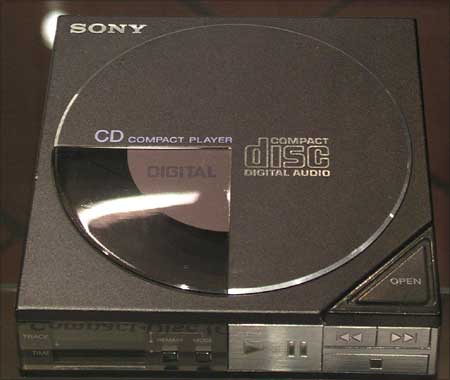On June 22, 1979, when the journalists arrived at the Sony Building located in the Ginza area of Tokyo, they were escorted onto a bus and each handed a Walkman.
They were taken to Yoyogi (a major park in Tokyo) and, after disembarking and receiving a brief greeting, they were instructed to put on the headphones and push the play button.
They saw that the yen 33,000 TPS-L2 model enabled them to listen to music of their choice, wherever and whenever they liked.
The Walkman went on sale on July 1, as planned, but by the end of July only 3,000 units had been sold. Sales finally topped 1.5 million units.
Sony Walkman is 30!
Image: Sony Walkman NW A 800.The first Sony Walkman was developed by Kozo Ohsone, general manager of the Sony Tape Recorder Business Division, and his staff, under the leadership of Sony founder and chief advisor, Masaru Ibuka, and honorary chairman Akio Morita.
There was a problem: The device didn't have a name. Ohsone suggested that they use the name "Walkman".
Several other names were suggested. Walky was the most popular, but none were as memorable as Walkman, so the name stayed.
Sony Walkman is 30!
Image: Sony Walkman WM- 2.WM- 2 established the Walkman brand name worldwide and was a runaway commercial success. Weighing just 250 gms, WM-2 was the lightest product of its kind in the world.
While WM- R2 was the first walkman with a recording function, with WM -20, Walkman was established as a modern necessity, easily carried in a handbag or pocket.
This model featured one AA battery, head, pinch roller, and headphone jack arranged in a row, with the cassette placed horizontally alongside this structure.
Sony Walkman is 30!
Image: Sony Walkman D-50.D-50 was the world's first portable CD player. Approximately the size of four CD cases, the body weighed 590g and sold at a surprisingly low price (less than 50,000 yen). This device single-handedly accelerated the spread of the CD.
In 1990 Sony introduced TCD-D3, the first ultracompact, lightweight DAT Walkman, small enough to fit in one's palm.
In 1992 came Scoopman NT-1, the world's first digital micro-recorder using ultra-compact tapes.
Sony Walkman is 30!
Image: Sony Walkman MZ-N1.The first product to support the NetMD standard for high-speed transfer of music data from PC to Walkman, MZ-N1 powered by a 'gum stick' sized rechargeable battery was capable of approximately 28 hours of playback in standard mode.
In 2003 Sony launched NW-MS70D.
Marketed simultaneously with 'Duo' Memory Stick, this device incorporated 256 MB of flash memory in a compact body.
It represented a new style of network Walkman enabling users to enjoy the equivalent of 11 CDs of music.
Sony Walkman is 30!
Image: Sony Walkman A SeriesIn 2007, Sony Walkman finally 'got the picture'.
Almost a year and a half after Apple unveiled its video iPod, the new A-series - which comes in 2, 4, or 8 GB models - has just three buttons, a departure from the buttons galore of the company's legacy products.
What's more, their 2-in. liquid-crystal-display color screens are rectangular, so you can choose to watch videos either vertically or horizontally.
Sony Walkman is 30!
Image: Sony Walkman NWZ-X1000.In January 2009, Sony introduced the new flagship to its Walkman music and video player lineup.
The Sony Walkman NWZ-X1000 is the first Wi-Fi enabled Walkman player. The music and video player will use Wi-Fi in combination with an Internet browser to surf the Web on the player's 3-inch screen.
The Sony Walkman X1000 is also the first music player with active noise cancellation built in.
For Internet features, the Sony Walkman X1000 will also have YouTube streaming capabilities.
Considering the Walkman's 16GB and 32GB capacities, same as the iPod touch, and the heavy emphasis on music and video quality, the battle is certainly raging.








article